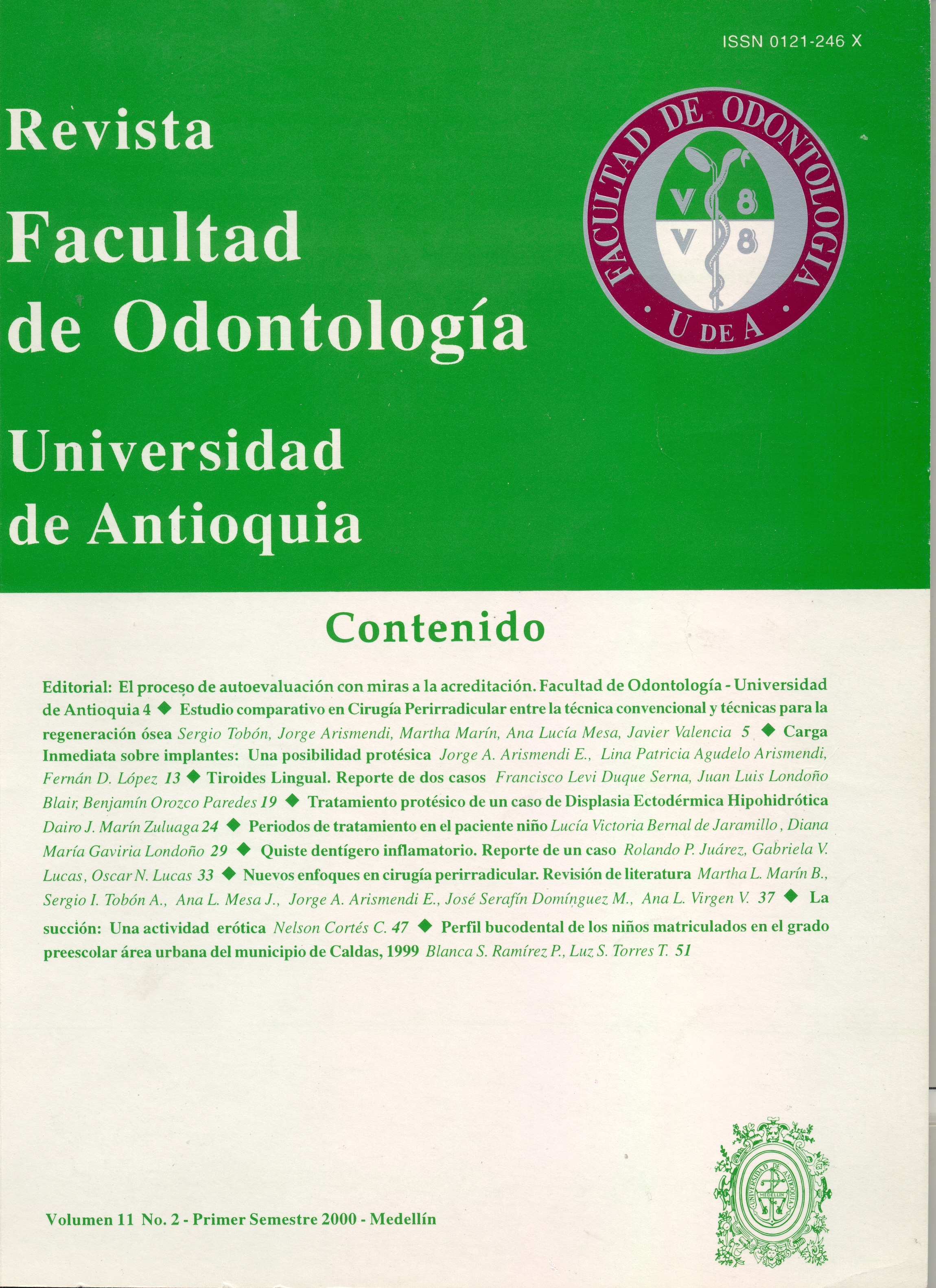Estudio comparativo en cirugía perirradicular entre la técnica convencional y técnicas para la regeneración ósea
DOI:
https://doi.org/10.17533/udea.rfo.2448Keywords:
Guided bone regeneration, Membranes, Periradicular surgery, Synthetic bone substitutesAbstract
It was intended to demonstrate the ellicacy 01 two materials 01 bone regeneration as assisting towerds therapy in periradicular surgery and their effect on the healing 01periapical tissues. Twenty eight petients (30 surgical sites). were selected and distributed in three groups: group A, conventional technique; graup B, conventional technique plus non-bioabsorbable Gore'Iex" Augmentation membrane and group C, conventional technique plus membrane and synthetic hlling material type bioebsorbeble hydroxyapatite (Osteoüert"). Clinical and radiological evaluations were made right belore the initial sur¿;ery, a week later and every three months alter surgery up to twelve months. Two histological evaluations were performed (at the beginning and at 12months). The results showed complete clinical and radiographic healing (100%) lor group C, with histologic reports 01trabecular bone for all the cases For group B, a 66.66% 01the cases showed complete radiographic healing, incomplete in a 11.11% and uncertain in 22.22%, with histologic results 01 trabecular bone in 62.5%.. scer tissue in 12.5% and granuloma in 25% 01 the cases. For group A there was a complete radiographic healing in 44.44%, incomplete in 44.44% and unsuccesslul in 11.11%, with report 01 granuloma in 50%, scar tissue in 25% and trabecular bone in 25% 01 the cases. !t was concluded that the conventional technique presents a high probability 01relepse and that the use 01 bone regeneration materials improves the predictability 01clinicel, radiographic and histological healing.
Downloads
Downloads
Published
How to Cite
Issue
Section
License
Copyright Notice
Copyright comprises moral and patrimonial rights.
1. Moral rights: are born at the moment of the creation of the work, without the need to register it. They belong to the author in a personal and unrelinquishable manner; also, they are imprescriptible, unalienable and non negotiable. Moral rights are the right to paternity of the work, the right to integrity of the work, the right to maintain the work unedited or to publish it under a pseudonym or anonymously, the right to modify the work, the right to repent and, the right to be mentioned, in accordance with the definitions established in article 40 of Intellectual property bylaws of the Universidad (RECTORAL RESOLUTION 21231 of 2005).
2. Patrimonial rights: they consist of the capacity of financially dispose and benefit from the work trough any mean. Also, the patrimonial rights are relinquishable, attachable, prescriptive, temporary and transmissible, and they are caused with the publication or divulgation of the work. To the effect of publication of articles in the journal Revista de la Facultad de Odontología, it is understood that Universidad de Antioquia is the owner of the patrimonial rights of the contents of the publication.
The content of the publications is the exclusive responsibility of the authors. Neither the printing press, nor the editors, nor the Editorial Board will be responsible for the use of the information contained in the articles.
I, we, the author(s), and through me (us), the Entity for which I, am (are) working, hereby transfer in a total and definitive manner and without any limitation, to the Revista Facultad de Odontología Universidad de Antioquia, the patrimonial rights corresponding to the article presented for physical and digital publication. I also declare that neither this article, nor part of it has been published in another journal.
Open Access Policy
The articles published in our Journal are fully open access, as we consider that providing the public with free access to research contributes to a greater global exchange of knowledge.
Creative Commons License
The Journal offers its content to third parties without any kind of economic compensation or embargo on the articles. Articles are published under the terms of a Creative Commons license, known as Attribution – NonCommercial – Share Alike (BY-NC-SA), which permits use, distribution and reproduction in any medium, provided that the original work is properly cited and that the new productions are licensed under the same conditions.
![]()
This work is licensed under a Creative Commons Attribution-NonCommercial-ShareAlike 4.0 International License.













